Feasibility of Barley Straw Fibers as Reinforcement in Fully Biobased Polyethylene Composites: Macro and Micro Mechanics of the Flexural Strength
Abstract
1. Introduction
2. Results
2.1. Fibers Characterization
2.2. Optimization of the Coupling Agent
2.3. Flexural Properties of Barley Fiber Composites
2.4. Intrinsic Flexural Strength Properties
3. Materials and Methods
3.1. Materials
3.2. Methods
3.2.1. Thermomechanical (TM) Barley Straw Fiber Production and Characterization
3.2.2. Composites Preparation and Sample Obtaining
3.2.3. Mechanical Test
4. Conclusions
Author Contributions
Funding
Acknowledgments
Conflicts of Interest
References
- United Nations, Department of Economic and Social Affairs. World Population Prospects 2019: Highlights; United Nations: New York. NY, USA, 2019. [Google Scholar]
- González, Z.; Rodríguez, A.; Vargas, F.; Jiménez, L. Influence of the operational variables on the pulping and beating of the orange tree pruning. Ind. Crops Prod. 2013, 49, 785–789. [Google Scholar] [CrossRef]
- González, Z.; Vargas, F.; Jiménez, L.; Rodríguez, A. Orange tree prunings as raw material for cellulose production by the Kraft process. Cell. Chem. Technol. 2013, 47, 603–611. [Google Scholar]
- Anastas, P.T.; Warner, J.C. Principles of green chemistry. In Green Chemistry: Theory and Practice; Oxford University: New York, NY, USA, 1998. [Google Scholar]
- Espinach, F.X.; Julian, F.; Verdaguer, N.; Torres, L.; Pelach, M.A.; Vilaseca, F.; Mutjé, P. Analysis of tensile and flexural modulus in hemp strands/polypropylene composites. Compos. Part B Eng. 2013, 47, 339–343. [Google Scholar] [CrossRef]
- Petts, J. Waste Incineration and The Environment; Royal Society of Chemistry: Cambridge, UK, 1994. [Google Scholar]
- Han, M.; Kang, K.E.; Kim, Y.; Choi, G.W. High efficiency bioethanol production from barley straw using a continuous pretreatment reactor. Process Biochem. 2013, 48, 488–495. [Google Scholar] [CrossRef]
- Mostafaeipour, A.; Sedaghat, A.; Hedayatpour, M.; Jahangiri, M. Location planning for production of bioethanol fuel from agricultural residues in the south of Caspian Sea. Environ. Dev. 2020, 33, 100500. [Google Scholar] [CrossRef]
- Rezania, S.; Oryani, B.; Cho, J.; Talaiekhozani, A.; Sabbagh, F.; Hashemi, B.; Rupani, P.F.; Mohammadi, A.A. Different pretreatment technologies of lignocellulosic biomass for bioethanol production: An overview. Energy 2020, 199, 117457. [Google Scholar] [CrossRef]
- Vargas, F.; González, Z.; Rojas, O.; Garrote, G.; Rodríguez, A. Barley Straw (Hordeum vulgare) as a Supplementary Raw Material for Eucalyptus camaldulensis and Pinus sylvestris Kraft Pulp in the Paper Industry. BioResources 2015, 10, 3682–3693. [Google Scholar] [CrossRef]
- Vargas, F.; González, F.; González, Z.; Sánchez, R.; Jiménez, L.; Rodríguez, A. Cellulosic pulps of cereal straws as raw material for the manufacture of ecological packaging. BioResources 2012, 7, 4161–4170. [Google Scholar]
- Everall, N.C.; Lees, D.R. The use of barley-straw to control general and blue-green algal growth in a Derbyshire reservoir. Water Res. 1996, 30, 269–276. [Google Scholar] [CrossRef]
- Spence, D.; Lembi, C. Evaluation of barley straw as an alternative algal control method in Northern California rice fields. J. Aquat. Plant. Manag. 2007, 45, 84–90. [Google Scholar]
- Cerdà, A.; González-Pelayo, Ó.; Giménez-Morera, A.; Jordán, A.; Pereira, P.; Novara, A.; Brevik, E.C.; Prosdocimi, M.; Mahmoodadbadi, M.; Keesstra, S.B.; et al. Use of barley straw residues to avoid high erosion and runoff rates on persimmon plantations in Eastern Spain under low frequency–high magnitude simulated rainfall events. Soil Res. 2016, 54, 154–165. [Google Scholar] [CrossRef]
- Prosdocimi, M.; Jordán, A.; Tarolli, P.; Keesstra, S.; Novara, A.; Cerdà, A. The immediate effectiveness of barley straw mulch in reducing soil erodibility and surface runoff generation in Mediterranean vineyards. Sci. Total Environ. 2016, 547, 323–330. [Google Scholar] [CrossRef] [PubMed]
- Yan, L.; Kasal, B.; Huang, L. A review of recent research on the use of cellulosic fibres, their fibre fabric reinforced cementitious, geo-polymer and polymer composites in civil engineering. Compos. Part B Eng. 2016, 92, 94–132. [Google Scholar] [CrossRef]
- Pickering, K.L.; Efendy, M.G.A.; Le, T.M. A review of recent developments in natural fibre composites and their mechanical performance. Compos. Part A Appl. Sci. Manuf. 2016, 83, 98–112. [Google Scholar] [CrossRef]
- Wirawan, R.; Sapuan, S.M.; Abdan, K.; Yunus, R.B. Tensile and impact properties of sugarcane bagasse/poly (vinyl chloride) composites. Key Eng. Mater. 2011, 471, 167–172. [Google Scholar] [CrossRef]
- Zabihzadeh, S.M. Influence of Plastic Type and Compatibilizer on Thermal Properties of Wheat Straw Flour/Thermoplastic Composites. J. Thermoplast. Compos. Mater. 2010, 23, 817–826. [Google Scholar] [CrossRef]
- Wang, W.; Yuan, S.; Bu, F.; Li, G.; Wang, Q. Wheat-Straw-HDPE Composite Produced by the Hot-pressing Method. J. Thermoplast. Compos. Mater. 2011, 24, 251–261. [Google Scholar] [CrossRef]
- Zhou, Y.; Fan, M.; Chen, L. Interface and bonding mechanisms of plant fibre composites: An overview. Compos. Part B Eng. 2016, 101, 31–45. [Google Scholar] [CrossRef]
- Tarrés, Q.; Vilaseca, F.; Herrera-Franco, P.J.; Espinach, F.X.; Delgado-Aguilar, M.; Mutjé, P. Interface and micromechanical characterization of tensile strength of bio-based composites from polypropylene and henequen strands. Ind. Crops Prod. 2019, 132, 319–326. [Google Scholar] [CrossRef]
- Scarponi, C.; Messano, M. Comparative evaluation between E-Glass and hemp fiber composites application in rotorcraft interiors. Compos. Part B Eng. 2015, 69, 542–549. [Google Scholar] [CrossRef]
- López, J.P.; Méndez, J.A.; Mansouri, N.E.E.; Mutjé, P.; Vilaseca, F. Mean intrinsic tensile properties of stone groundwood fibers from softwood. BioResources 2011, 6, 5037–5049. [Google Scholar] [CrossRef]
- Salem, S.; Oliver-Ortega, H.; Espinach, F.X.; Hamed, K.B.; Nasri, N.; Alcalà, M.; Mutjé, P. Study on the Tensile Strength and Micromechanical Analysis of Alfa Fibers Reinforced High Density Polyethylene Composites. Fibers Polym. 2019, 20, 602–610. [Google Scholar] [CrossRef]
- Sullins, T.; Pillay, S.; Komus, A.; Ning, H. Hemp fiber reinforced polypropylene composites: The effects of material treatments. Compos. Part B Eng. 2017, 114, 15–22. [Google Scholar] [CrossRef]
- Kumar, R.; Ul-Haq, M.I.; Raina, A.; Anand, A. Industrial applications of natural fibre-reinforced polymer composites–challenges and opportunities. Int. J. Sustain. Eng. 2019, 12, 212–220. [Google Scholar] [CrossRef]
- Vallejos, M.E.; Espinach, F.X.; Julián, F.; Torres, L.; Vilaseca, F.; Mutjé, P. Micromechanics of hemp strands in polypropylene composites. Compos. Sci. Technol. 2012, 72, 1209–1213. [Google Scholar] [CrossRef]
- Masłowski, M.; Miedzianowska, J.; Strzelec, K. Natural rubber biocomposites containing corn, barley and wheat straw. Polym. Test. 2017, 63, 84–91. [Google Scholar] [CrossRef]
- Bouasker, M.; Belayachi, N.; Hoxha, D.; Al-Mukhtar, M. Physical Characterization of Natural Straw Fibers as Aggregates for Construction Materials Applications. Materials 2014, 7, 3034–3048. [Google Scholar] [CrossRef]
- Bederina, M.; Belhadj, B.; Ammari, M.S.; Gouilleux, A.; Makhloufi, Z.; Montrelay, N.; Quéneudéc, M. Improvement of the properties of a sand concrete containing barley straws - Treatment of the barley straws. Constr. Build. Mater. 2016, 115, 464–477. [Google Scholar] [CrossRef]
- Belhadj, B.; Bederina, M.; Makhloufi, Z.; Dheilly, R.M.; Montrelay, N.; Quéneudéc, M. Contribution to the development of a sand concrete lightened by the addition of barley straws. Constr. Build. Mater. 2016, 113, 513–522. [Google Scholar] [CrossRef]
- Hyvärinen, M.; Kärki, T. The Effects of the Substitution of Wood Fiberwith Agro-based Fiber (Barley Straw) on the Properties of Natural Fiber/Polypropylene Composites. MATEC Web Conf. 2015, 30, 01014. [Google Scholar] [CrossRef]
- Silva-Guzmán, J.A.; Anda, R.R.; Fuentes-Talavera, F.J.; Manríquez-González, R.; Lomelí-Ramírez, M.G. Properties of Thermoplastic Corn Starch Based Green Composites Reinforced with Barley (Hordeum vulgare L.) Straw Particles Obtained by Thermal Compression. Fibers Polym. 2018, 19, 1970–1979. [Google Scholar] [CrossRef]
- Rojas-Leon, A.; Guzmán-Ortiz, F.A.; Bolarín-Miró, A.M.; Otazo-Sánchez, E.M.; Prieto-García, F.; Fuentes-Talavera, F.J.; Román-Gutierrez, A.D. Eco-innovation of barley and HDPE wastes: A proposal of sustainable particleboards. Rev. Mex. Ing. Química 2019, 18, 57–68. [Google Scholar] [CrossRef]
- Serra-Parareda, F.; Tarrés, Q.; Delgado-Aguilar, M.; Espinach, F.X.; Mutjé, P.; Vilaseca, F. Biobased Composites from Biobased-Polyethylene and Barley Thermomechanical Fibers: Micromechanics of Composites. Materials 2019, 12, 4182. [Google Scholar] [CrossRef] [PubMed]
- Tarrés, Q.; Oliver-Ortega, H.; Espinach, F.X.; Mutjé, P.; Delgado-Aguilar, M.; Méndez, J.A. Determination of Mean Intrinsic Flexural Strength and Coupling Factor of Natural Fiber Reinforcement in Polylactic Acid Biocomposites. Polymers 2019, 11, 1736. [Google Scholar] [CrossRef]
- Espinach, F.X.; Méndez, J.A.; Granda, L.A.; Pelach, M.A.; Delgado-Aguilar, M.; Mutjé, P. Bleached kraft softwood fibers reinforced polylactic acid composites, tensile and flexural strengths. Nat. Fiber-Reinforced Biodegrad. Bioresorbable Polym. Compos. 2017, 73–90. [Google Scholar] [CrossRef]
- Gironès, J.; Lopez, J.P.; Vilaseca, F.; Bayer, R.; Herrera-Franco, P.J.; Mutjé, P. Biocomposites from Musa textilis and polypropylene: Evaluation of flexural properties and impact strength. Compos. Sci. Technol. 2011, 71, 122–128. [Google Scholar] [CrossRef]
- Oliver-Ortega, H.; Julian, F.; Espinach, F.X.; Tarrés, Q.; Ardanuy, M.; Mutjé, P. Research on the use of lignocellulosic fibers reinforced bio-polyamide 11 with composites for automotive parts: Car door handle case study. J. Clean. Prod. 2019, 226, 64–73. [Google Scholar] [CrossRef]
- Serrano, A.; Espinach, F.X.; Tresserras, J.; Pellicer, N.; Alcala, M.; Mutje, P. Study on the technical feasibility of replacing glass fibers by old newspaper recycled fibers as polypropylene reinforcement. J. Clean. Prod. 2014, 65, 489–496. [Google Scholar] [CrossRef]
- Doan, T.T.L.; Gao, S.L.; Mäder, E. Jute/polypropylene composites I. Effect of matrix modification. Compos. Sci. Technol. 2006, 66, 952–963. [Google Scholar] [CrossRef]
- Granda, L.A.; Espinach, F.X.; Tarrés, Q.; Méndez, J.A.; Delgado-Aguilar, M.; Mutjé, P. Towards a good interphase between bleached kraft softwood fibers and poly(lactic) acid. Compos. Part B Eng. 2016, 99, 514–520. [Google Scholar] [CrossRef]
- Amuthakkannan, P.; Manikandan, V.; Winowlin-Jappes, J.T.; Uthayakumar, M. Effect of fibre length and fibre content on mechanical properties of short basalt fibre reinforced polymer matrix composites. Mater. Phys. Mech. 2016, 16, 107–117. [Google Scholar]
- Serra-Parareda, F.; Tarrés, Q.; Espinach, F.X.; Vilaseca, F.; Mutjé, P.; Delgado-Aguilar, M. Influence of lignin content on the intrinsic modulus of natural fibers and on the stiffness of composite materials. Int. J. Biol. Macromol. 2020, 115, 81–90. [Google Scholar] [CrossRef] [PubMed]
- Ververis, C.; Georghiou, K.; Christodoulakis, N.; Santas, P.; Santas, R. Fiber dimensions, lignin and cellulose content of various plant materials and their suitability for paper production. Ind. Crops Prod. 2004, 19, 245–254. [Google Scholar] [CrossRef]
- Reixach, R.; Franco-Marquès, E.; El Mansouri, N.E.; Ramirez de Cartagena, F.; Arbat, G.; Espinach, F.X.; Mutjé, P. Micromechanics of Mechanical, Thermomechanical, and Chemi-Thermomechanical Pulp from Orange Tree Pruning as Polypropylene Reinforcement: A Comparative Study. BioResources 2013, 8, 3231–3246. [Google Scholar] [CrossRef]
- Theng, D.; Arbat, G.; Delgado-Aguilar, M.; Vilaseca, F.; Ngo, B.; Mutjé, P. All-lignocellulosic fiberboard from corn biomass and cellulose nanofibers. Ind. Crops Prod. 2015, 76, 166–173. [Google Scholar] [CrossRef]
- Tarrés, Q.; Soler, J.; Rojas-Sola, J.I.; Oliver-Ortega, H.; Julián, F.; Espinach, F.X.; Mutjé, P.; Delgado-Aguilar, M. Flexural Properties and Mean Intrinsic Flexural Strength of Old Newspaper Reinforced Polypropylene Composites. Polymers 2019, 11, 1244. [Google Scholar] [CrossRef]
- Mutjé, P.; Vallejos, M.E.; Gironès, J.; Vilaseca, F.; López, A.; López, J.P.; Méndez, J.A. Effect of maleated polypropylene as coupling agent for polypropylene composites reinforced with hemp strands. J. Appl. Polym. Sci. 2006, 102, 833–840. [Google Scholar] [CrossRef]
- Franco-Marquès, E.; Méndez, J.A.; Pèlach, M.A.; Vilaseca, F.; Bayer, J.; Mutjé, P. Influence of coupling agents in the preparation of polypropylene composites reinforced with recycled fibers. Chem. Eng. J. 2011, 166, 1170–1178. [Google Scholar] [CrossRef]
- Granda, L.A.; Espinach, F.X.; López, F.; García, J.C.; Delgado-Aguilar, M.; Mutjé, P. Semichemical fibres of Leucaena collinsii reinforced polypropylene: Macromechanical and micromechanical analysis. Compos. Part B Eng. 2016, 91, 384–391. [Google Scholar] [CrossRef]
- Faruk, O.; Bledzki, A.K.; Fink, H.P.; Sain, M. Biocomposites reinforced with natural fibers: 2000–2010. Prog Polym. Sci. 2012, 37, 1552–1596. [Google Scholar] [CrossRef]
- Reis, P.N.B.; Ferreira, J.A.M.; Silva, P.A.A. Mechanical behaviour of composites filled by agro-waste materials. Fibers Polym. 2011, 12, 240–246. [Google Scholar] [CrossRef]
- Mirmehdi, S.M.; Zeinaly, F.; Dabbagh, F. Date palm wood flour as filler of linear low-density polyethylene. Compos. Part B Eng. 2014, 56, 137–141. [Google Scholar] [CrossRef]
- López, J.P.; Gironès, J.; Mendez, J.A.; Pèlach, M.A.; Vilaseca, F.; Mutjé, P. Impact and flexural properties of stone-ground wood pulp-reinforced polypropylene composites. Polym. Compos. 2013, 34, 842–848. [Google Scholar] [CrossRef]
- Turker, D.; Nadir, A.; Büyüksari, U. Utilization of waste pine cone in manufacture of wood/plastic composite. In Proceedings of the Second International Conference on Sustainable Construction Materials and Technologies, Ancona, Italy, 28–30 June 2010; Volume 3, pp. 1517–1528. [Google Scholar]
- Zhang, K.; Barhoum, A.; Chen, X.; Li, H.; Samyn, P. Cellulose Nanofibers: Fabrication and Surface Functionalization Techniques. In Handbook of Nanofibers; Springer Nature Switzerland AG: Cham, Switzerland, 2019. [Google Scholar] [CrossRef]
- Bledzki, A.K.; Gassan, J. Composites reinforced with cellulose based fibres. Prog. Polym. Sci. 1999, 24, 221–274. [Google Scholar] [CrossRef]
- Bledzki, A.K.; Gassan, J.; Theis, S. Wood-filled thermoplastic composites. Mech. Compos. Mater. 1998, 34, 563–568. [Google Scholar] [CrossRef]
- Shebani, A.N.; Van Reenen, A.J.; Meincken, M. The Effect of Wood Species on the Mechanical and Thermal Properties of Wood—LLDPE Composites. J. Compos. Mater. 2009, 43, 1305–1318. [Google Scholar] [CrossRef]
- Vilaseca, F.; Valadez-Gonzalez, A.; Herrera-Franco, P.J.; Pèlach, M.À.; López, J.P.; Mutjé, P. Biocomposites from abaca strands and polypropylene. Part I: Evaluation of the tensile properties. Bioresour. Technol. 2010, 101, 387–395. [Google Scholar] [CrossRef]
- Alcalá, M.; González, I.; Boufi, S.; Vilaseca, F.; Mutjé, P. All-cellulose composites from unbleached hardwood kraft pulp reinforced with nanofibrillated cellulose. Cellulose 2013, 20, 2909–2921. [Google Scholar] [CrossRef]
- Serra, A.; Tarrés, Q.; Chamorro, M.À.; Soler, J.; Mutjé, P.; Espinach, F.X.; Vilaseca, F. Modeling the Stiffness of Coupled and Uncoupled Recycled Cotton Fibers Reinforced Polypropylene Composites. Polymers 2019, 11, 1725. [Google Scholar] [CrossRef]
- Kelly, A.; Tyson, W.R. Tensile properties of fibre-reinforced metals: Copper/tungsten and copper/molybdenum. J. Mech. Phys. Solids 1965, 13, 329–338. [Google Scholar] [CrossRef]
- Bowyer, W.H.; Bader, M.G. On the re-inforcement of thermoplastics by imperfectly aligned discontinuous fibres. J. Mater. Sci. 1972, 7, 1315–1321. [Google Scholar] [CrossRef]
- Hashemi, S. Hybridisation effect on flexural properties of single- and double-gated injection moulded acrylonitrile butadiene styrene (ABS) filled with short glass fibres and glass beads particles. J. Mater. Sci. 2008, 43, 4811–4819. [Google Scholar] [CrossRef]
- Pimenta, M.T.B.; Carvalho, A.J.F.; Vilaseca, F.; Girones, J.; López, J.P.; Mutjé, P.; Curvelo, A.A.S. Soda-treated sisal/polypropylene composites. J. Polym. Environ. 2008, 16, 35–39. [Google Scholar] [CrossRef]
- Thomason, J. Interfacial strength in thermoplastic composites–at last an industry friendly measurement method? Compos. Part A Appl. Sci. Manuf. 2002, 33, 1283–1288. [Google Scholar] [CrossRef]
Sample Availability: Samples of the compounds are not available from the authors. |


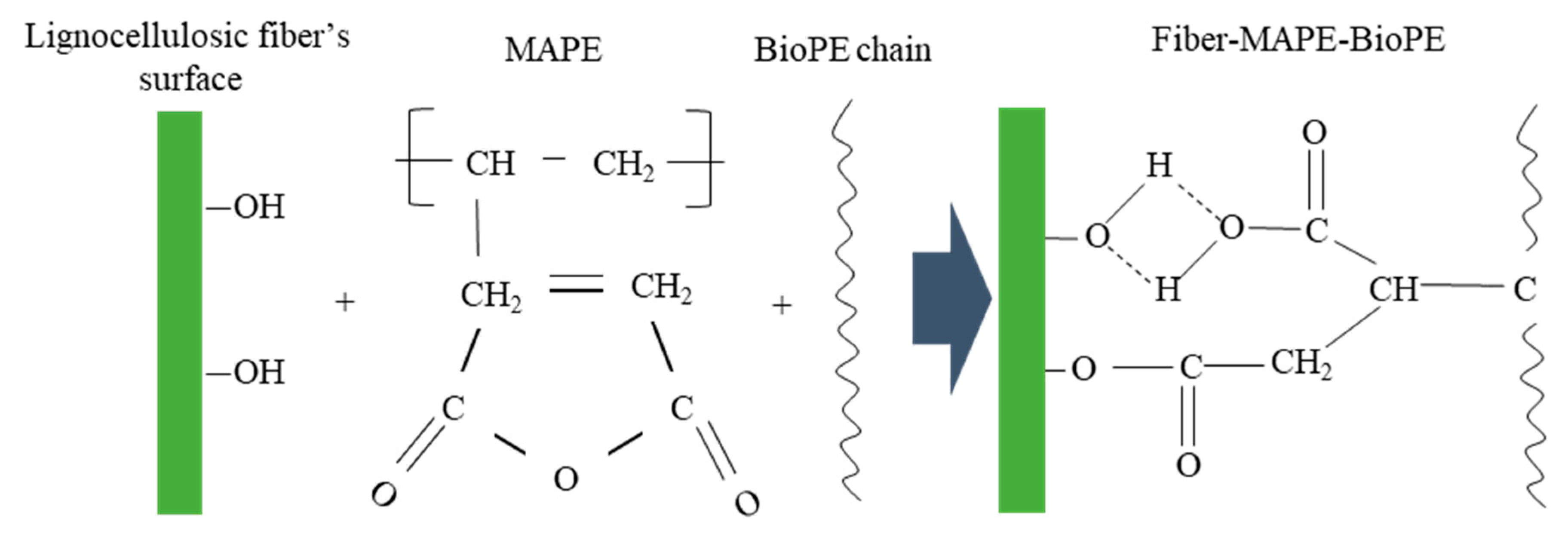
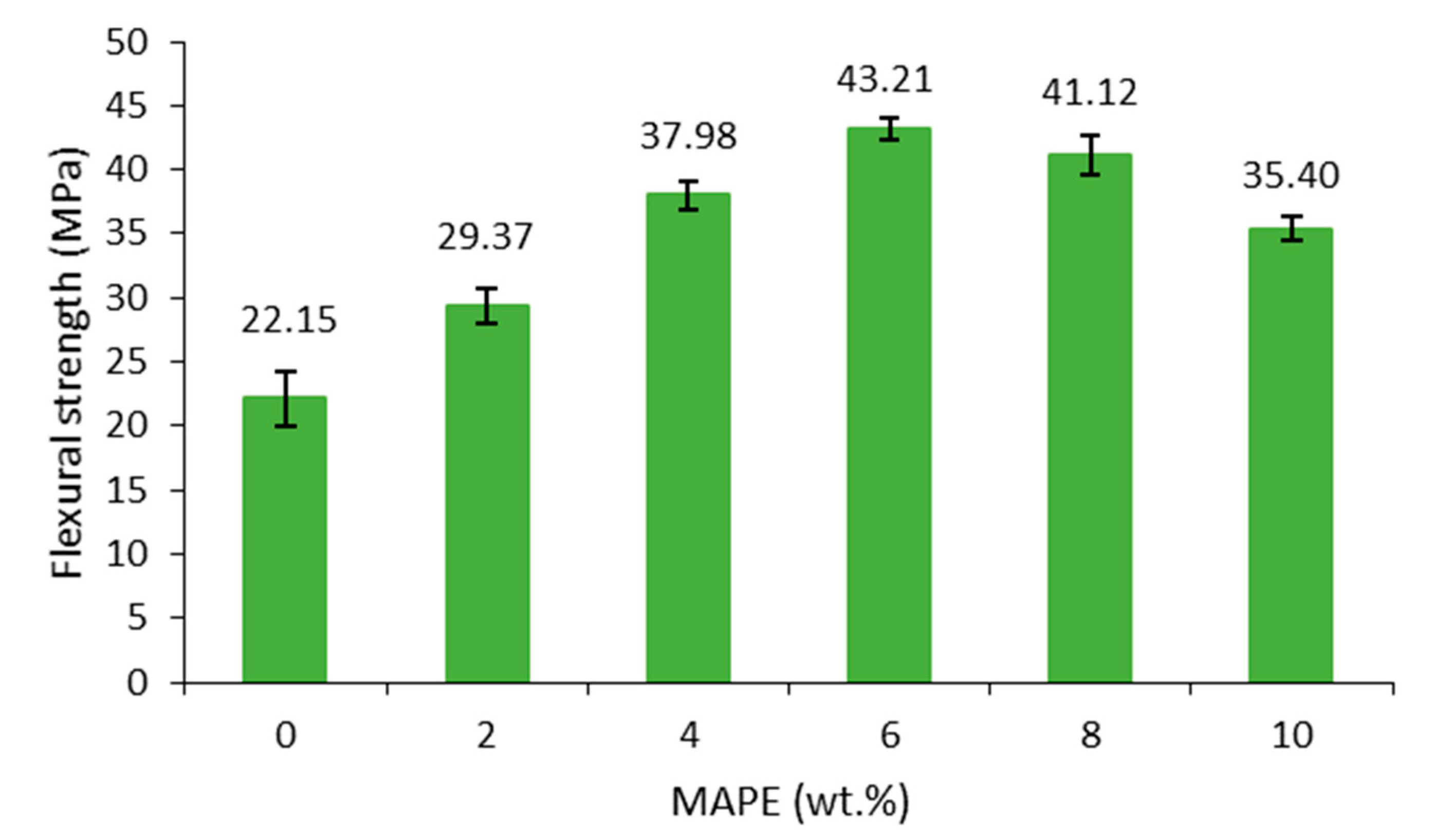

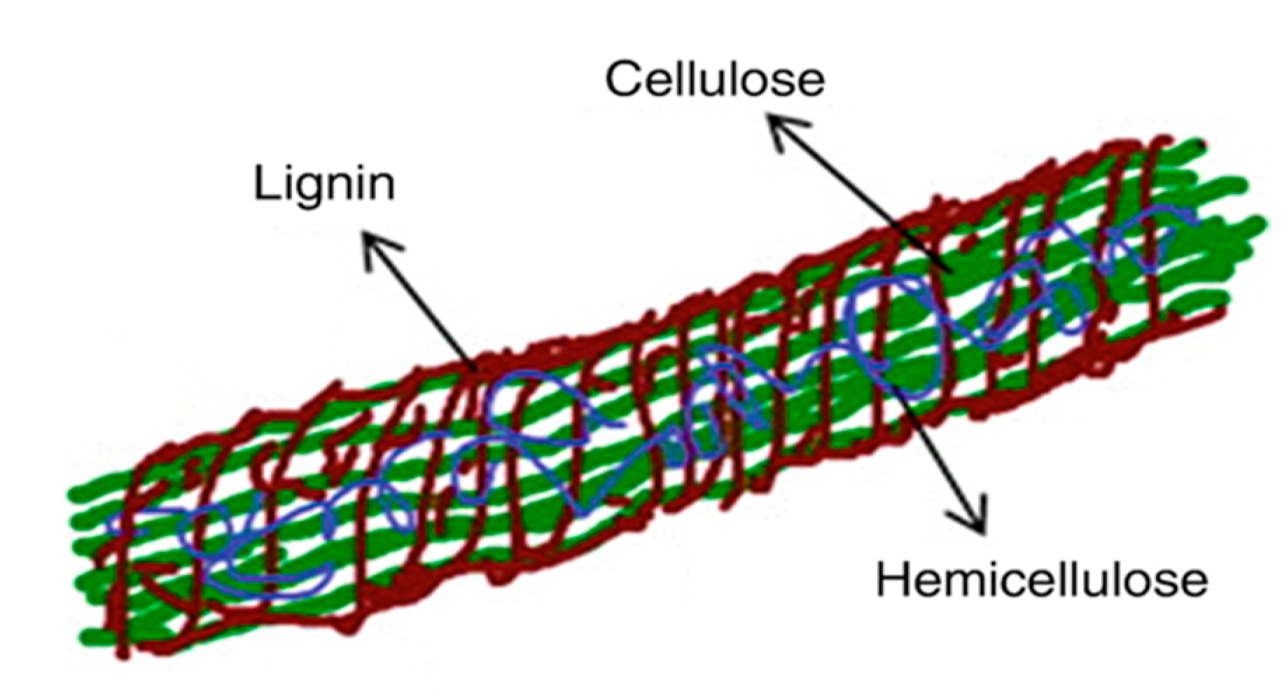
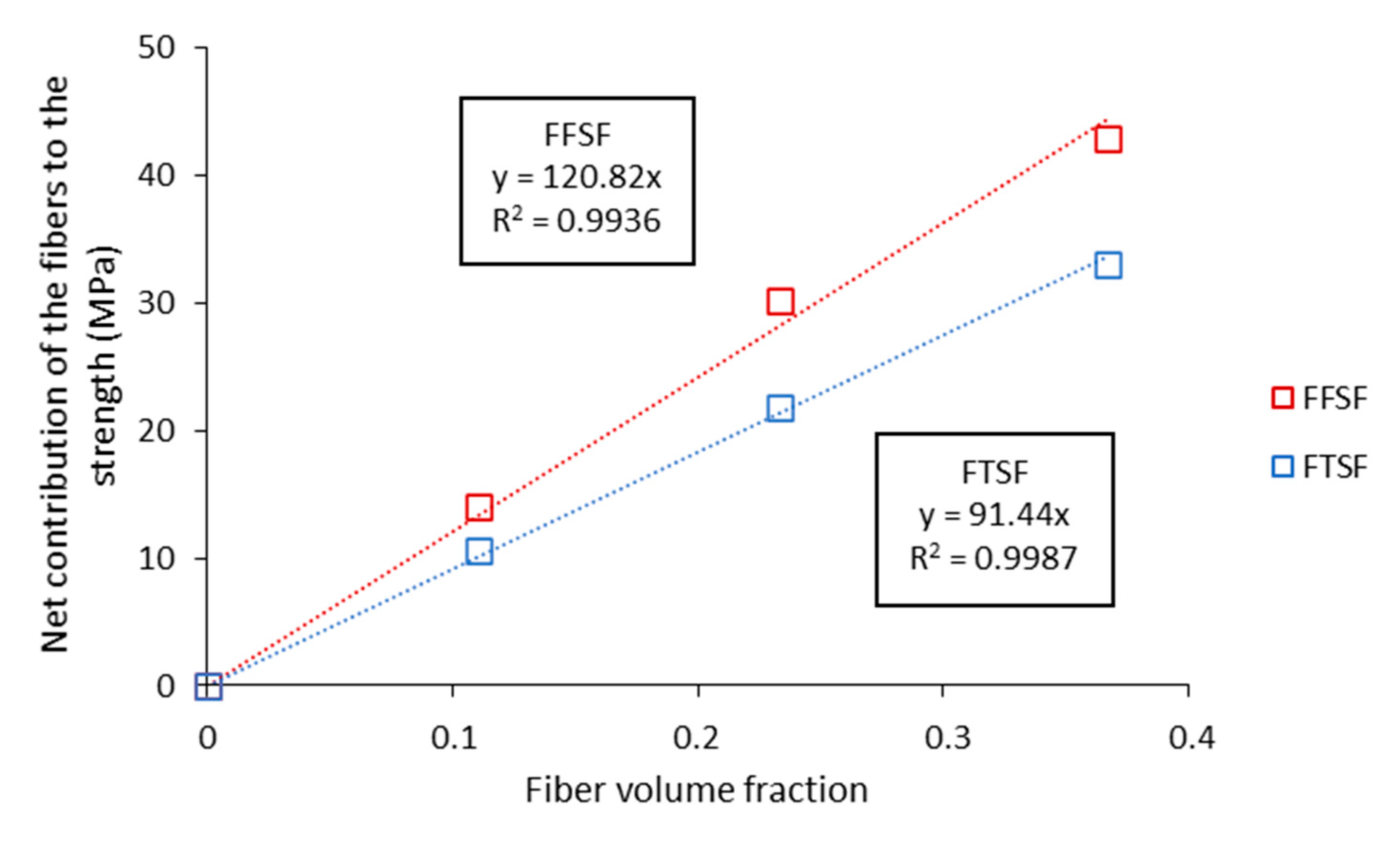
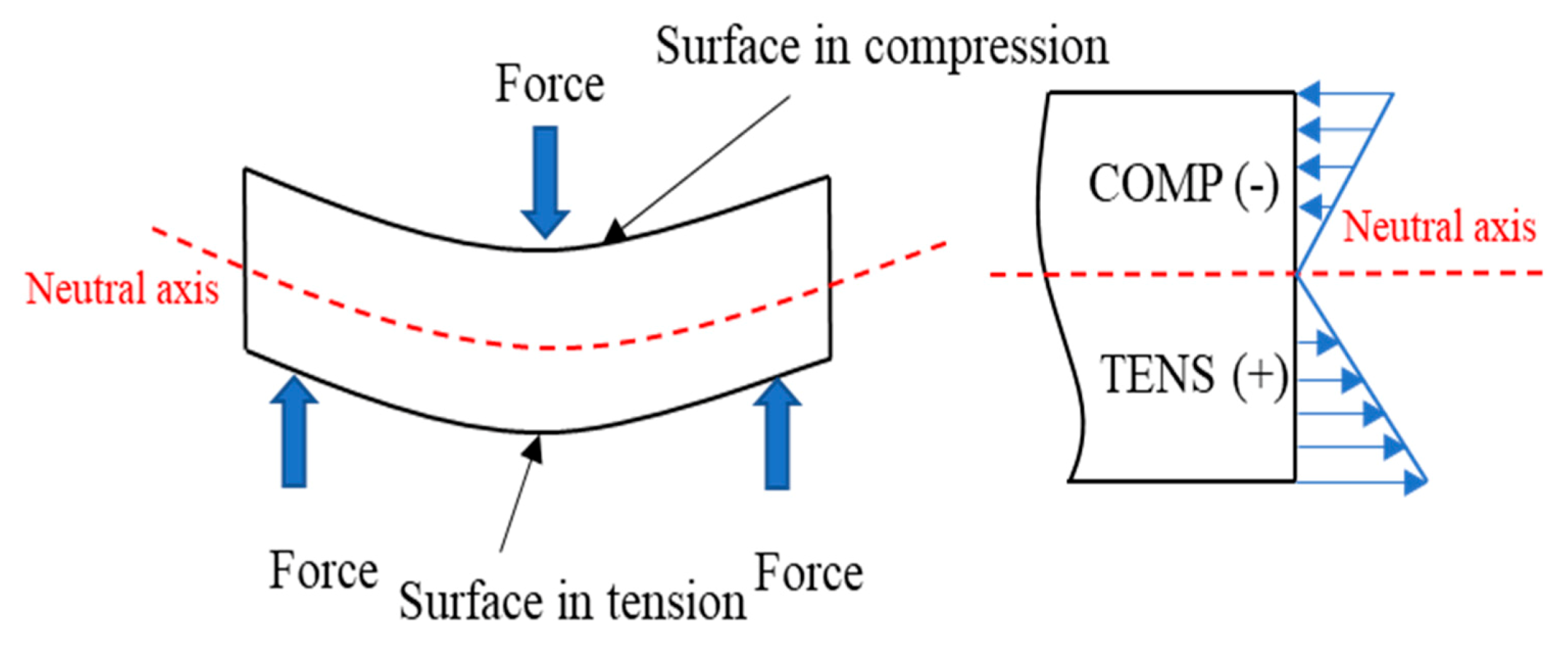
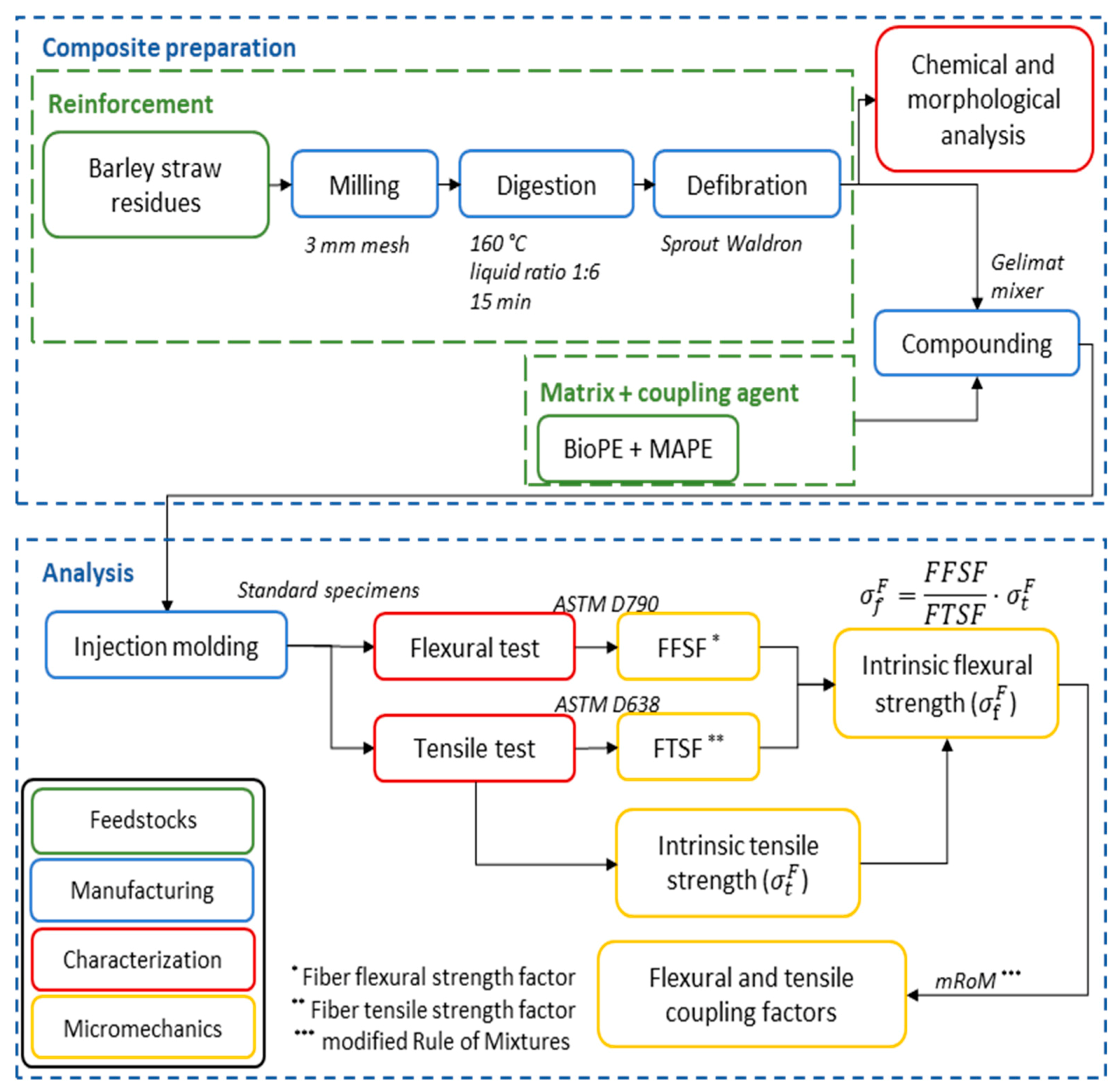
| Composition/Morphology | Barley Straw | Barley TMP Fibers |
|---|---|---|
| Holocellulose (wt.%) | 70.12 ± 0.54 | 77.67 ± 0.61 |
| Klason lignin (wt.%) | 16.45 ± 0.34 | 15.30 ± 0.46 |
| Extractives (wt.%) | 5.90 ± 0.76 | 2.73 ± 0.12 |
| Ashes (wt.%) | 7.1 ± 0.2 | 4.3 ± 0.3 |
| Length 1 (μm) | - | 745 ± 21 |
| Diameter (μm) | - | 19.6 ± 0.6 |
| Aspect ratio (length/diameter) | - | 38.0 |
| Sample | Reinforcement (wt.%) | Vf | σfc (MPa) | εfc (%) | σfm* (MPa) |
|---|---|---|---|---|---|
| BioPE | 0 | 0 | 21.25 ± 0.95 | 7.18 ± 0.41 | 21.25 |
| BioPE/Barley fibers | 15 | 0.111 | 30.21 ± 1.23 | 4.03 ± 0.28 | 18.21 |
| 30 | 0.233 | 43.21 ± 0.89 | 3.52 ± 0.31 | 16.98 | |
| 45 | 0.367 | 52.45 ± 1.45 | 2.85 ± 0.19 | 15.14 |
| Sample | Reinforcement (wt.%) | Vf | σtc (MPa) | εtc (%) | σtm* (MPa) |
|---|---|---|---|---|---|
| BioPE | 0 | 0 | 18.05 ± 0.74 | 12.18 ± 0.34 | 18.05 |
| BioPE/Barley fibers | 15 | 0.111 | 25.21 ± 0.64 | 7.65 ± 0.24 | 16.37 |
| 30 | 0.233 | 34.70 ± 0.90 | 6.45 ± 0.31 | 16.76 | |
| 45 | 0.367 | 43.10 ± 0.57 | 4.69 ± 0.33 | 15.86 |
| Sample | Reinforcement (wt.%) | Tensile | Flexural | |||
|---|---|---|---|---|---|---|
| σtF (MPa) | fc,t | σfF (MPa) | fc,f | |||
| BioPE + barley | 15 | 1.32 | 532.9 | 0.18 | 703.4 | 0.18 |
| 30 | 521.2 | 0.18 | 688.0 | 0.19 | ||
| 45 | 500.5 | 0.18 | 660.7 | 0.18 | ||
© 2020 by the authors. Licensee MDPI, Basel, Switzerland. This article is an open access article distributed under the terms and conditions of the Creative Commons Attribution (CC BY) license (http://creativecommons.org/licenses/by/4.0/).
Share and Cite
Serra-Parareda, F.; Julián, F.; Espinosa, E.; Rodríguez, A.; Espinach, F.X.; Vilaseca, F. Feasibility of Barley Straw Fibers as Reinforcement in Fully Biobased Polyethylene Composites: Macro and Micro Mechanics of the Flexural Strength. Molecules 2020, 25, 2242. https://doi.org/10.3390/molecules25092242
Serra-Parareda F, Julián F, Espinosa E, Rodríguez A, Espinach FX, Vilaseca F. Feasibility of Barley Straw Fibers as Reinforcement in Fully Biobased Polyethylene Composites: Macro and Micro Mechanics of the Flexural Strength. Molecules. 2020; 25(9):2242. https://doi.org/10.3390/molecules25092242
Chicago/Turabian StyleSerra-Parareda, Ferran, Fernando Julián, Eduardo Espinosa, Alejandro Rodríguez, Francesc X. Espinach, and Fabiola Vilaseca. 2020. "Feasibility of Barley Straw Fibers as Reinforcement in Fully Biobased Polyethylene Composites: Macro and Micro Mechanics of the Flexural Strength" Molecules 25, no. 9: 2242. https://doi.org/10.3390/molecules25092242
APA StyleSerra-Parareda, F., Julián, F., Espinosa, E., Rodríguez, A., Espinach, F. X., & Vilaseca, F. (2020). Feasibility of Barley Straw Fibers as Reinforcement in Fully Biobased Polyethylene Composites: Macro and Micro Mechanics of the Flexural Strength. Molecules, 25(9), 2242. https://doi.org/10.3390/molecules25092242











